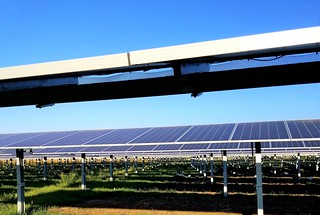 Courtesy Monarch Joint Venture
Courtesy Monarch Joint VentureRenewable Energy Meets Pollinator Habitat in Minnesota Solar Fields
Guest blog post by Monarch Joint Venture
Up to 99% of native northern tallgrass prairie in the U.S. has disappeared since European settlement (Samson and Knopf, 1994). This loss of habitat is devastating for pollinators including the iconic…

Case Study: Vermont Farmers Access Clean Energy
Farmer-members of Organic Valley, a farmer-owned cooperative representing nearly 1,800 family farms, can now access renewable energy options for their operations. In Vermont, solar development company SunCommon has created a program to help…

Solar PV and the Importance of Asking for High-Performance Ground Cover
By Rob Davis, Connexus Energy
Seven years after designing our first solar array, more than 20 million deep-rooted and pollinator-friendly plants across more than 150 acres are helping us control costs while maximizing local benefits for…

Resources for Land Access
By Victorian Smart, NCAT Energy Program Assistant
If you dream of owning land someday, you’ve probably also experienced apprehension about the process of finding and buying the land. This is the reality of land acquisition – it is financially…

Watch: Agrivoltaics as a Climate-Smart Conservation Cropping Practice, Jack’s Solar Garden, and the AgriSolar Clearinghouse
In this webinar from the Indiana Conservation Cropping System Initiative, AgriSolar Clearinghouse partner Greg Barron-Gafford provides an agrivoltaics primer and a discussion of potential for agrivoltaics in climate-smart crop practices. Byron…

Case Study: Saffron and Solar Farms
The North American Center for Saffron Research and Development is conducting a multi-year study of saffron crops grown under and adjacent to ground-mounted solar arrays. The study, which began in 2015, includes two years of field data from…

Monadnock Region Community Supported Solar Case Study
The Monadnock Region Community Supported Solar project in New Hampshire is bringing together farmers, investors, and champions with a goal of helping local farms realize the potential of the renewable energy economy.
Community-supported…

Pollinator-Friendly Solar Pairs Economic Development, Conservation Goals
Written By: Cody Smith
As communities across the nation continue to embrace a future powered by clean energy, new solar farms are offering an opportunity to pair economic development and conservation goals. As landowners, project developers,…

The Solar Game
By: Wexus Technologies
Here’s a dirty secret: growers, processors, homeowners, and commercial businesses are spending too much money on solar energy installations. When many people think about their energy usage and getting relief from…

WEBINAR: Native Vegetation + Solar Energy
Cody Smith, policy associate at the Center for Rural Affairs, hosts this webinar on best management practices for implementing native vegetation on solar project sites in the region with Rob Davis, director of the Center for Pollinators in Energy at Fresh Energy.

Grazing Solar Sites Provides Benefits to Land and Farmers
By Heidi Kolbeck-Urlacher, Senior Policy Associate, Center for Rural Affairs
On a chilly September afternoon, a flock of Targhee/Rambouillet cross sheep quietly wander the grounds of an 18-acre solar garden site in southwestern…

Dual Use in the Pacific Northwest
When I think about dual-use solar, I think about why this approach is a good idea for the Pacific Northwest. In a region that enjoys wild, open areas, it would be easy to assume that there’s “plenty of space” for building solar. Of course, as we look closer, we realize that there are many uses and users of these spaces and lands - between agriculture, conservation, and the plentiful ways to recreate in the great outdoors of the Pacific Northwest. Oregon and Washington have rich agricultural economies and histories that are entwined with their natural resources and beauty. As a native Oregonian myself, I recognize the connection I have and value I place on these pristine spaces and activities. Protecting those spaces and activities is important to many.



